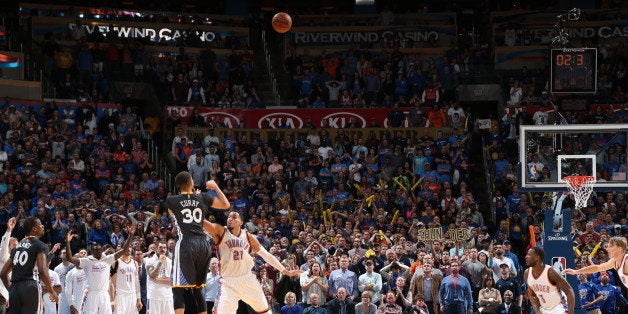
Steph Curry is having a magical year. Even Lebron James had to marvel Saturday night at Curry's 12 three-pointers and 46 points, including the pull-up, game-winning three-pointer from 38 feet away. Said Lebron: "@StephenCurry30 needs to stop it man!! He's ridiculous man! Never before seen someone like him in the history of ball!"
When Curry's career is over, he may go down as the best shooter -- and even perhaps best player -- to ever play the game. Not since Michael Jordan has one player seemed so unstoppable. Steph's shooting 51.5 percent from the field, including 46.8 percent from three-point territory. From 28 to 50 feet (meaning very deep 3-point shots), Curry's even better: 67.3 percent. How can this be? The farther away Steph shoots, his percentage is even higher.
The reason appears to be quite simple: the farther away Curry is from the basket, the less likely a defender will be guarding him closely. Oklahoma City Thunder's lax defense on Curry's 38-footer is a prime example. Andre Roberson was probably 10 feet away when Curry pulled up to take the shot. Curry had a wide-open shot, notwithstanding Roberson's desperation attempt to close the gap and contest the shot. Too late.
Nate Silver's analysis shows that Curry's three-point percentage plummets to around 15 percent when he's guarded close with less than two feet of space between the defender. So why don't NBA defenses defend Curry more closely? The conventional wisdom is that Curry will blow by the defender will his amazing ball skills. That may be true with one defender, but would it be easy for Curry to blow by two defenders on a double team?
The basic idea of the double team would be to deny Curry from shooting three-pointers, or at the very least wide open three-pointers. This strategy has several advantages. First, simple math says that two is less than three. If Curry makes 12 two-pointers, that's 24. If he makes 12 three-pointers, that's, well, you can do the math. Second, making Curry drive the lane would force him to expend more energy and take more of a bruising inside. If more defenses forced Curry to drive the lane instead of lofting open three-point shots, the defenses might end up reducing Curry's points (simply by subtracting the extra point from threes) and requiring him to expend more energy in driving and jumping among defenders in the lane. In last Saturday's game, Oklahoma City could have won if four of Curry's 12 three-pointers were defended to force Curry to drive the lane. Of course, Curry could always pass the ball to one of the other three-point sharp shooters on Golden State, but every defense must pick its poison. Taking the ball out of the best player's hands forces the other Golden State players to beat you.
That defensive strategy worked at least temporarily against Michael Jordan. The Detroit Pistons devised the "Jordan Rules" in which they relentlessly double teamed Michael Jordan to take the ball out of his hands. Detroit also played Jordan physically when he drove the lane. As the below video analysis shows, Detroit extended the double team of Jordan when Jordan brought up the ball. In this link, one of Detroit's big men doubled Jordan around 38 feet from the bucket (the same distance Curry shot his game winner on Saturday).
Hall of Famer Oscar Robertson received a lot flak for his suggestion that Curry's impressive shooting numbers are aided by the lax defense played today, as well as poor defensive coaching:
He's shot well because of what's going on in basketball today. In basketball today, it's almost like if you can dunk or make a three-point shot, you're the greatest thing since sliced bread. There have been some great shooters in the past. ... But here again, when I played years ago, if you shot a shot outside and hit it, the next time I'm going to be up on top of you. I'm going to pressure you with three-quarters, half-court defense. But now they don't do that. These coaches do not understand the game of basketball, as far as I'm concerned.
Perhaps it is unbecoming a Hall of Famer to appear to slight Curry's amazing skills and truly unbelievable performance this year. But, from a coaching standpoint, on how best to defend Steph Curry, Robertson's comments appear to make a lot of sense. Curry has the highest personal three-point percentage from 28 feet and beyond (67 percent), but his percentage dips to a a pedestrian 15 percent when a defender is smothering him.
These stats don't lie. If teams want to stop or at least slow down Steph Curry, teams must extend their defense -- including with traps and double teams -- all the way to three-quarters court and half court. Because Curry has much farther shooting range than Jordan (and perhaps every basketball player in history), defenses must adjust to fit his range. Under the Curry Rules, the double team on Curry should start as soon as or even before he touches the ball in the back court.
Will it stop Steph Curry? The career of the last truly unstoppable NBA superstar provides a guide. Jordan's talents were too many and too extraordinary to keep him from eventually winning six championships with the Chicago Bulls. But the Jordan Rules did work from 1988 to 1990, during which Detroit beat Chicago in three successive playoff series. Similarly, the Curry Rules might help slow Curry down. But his talents are too many and too extraordinary to stop.